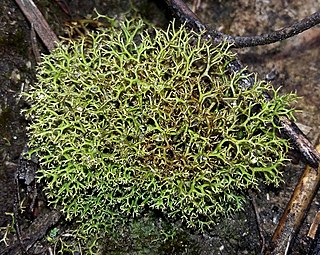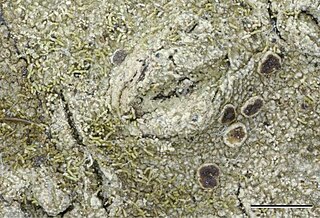
The Pertusariales are an order of fungi in the class Lecanoromycetes, comprising 8 families, 31 genera, and over 600 species, many of which form lichens. This diverse group is characterized by complex taxonomic history and ongoing phylogenetic revisions. Originally proposed by Maurice Choisy in 1949 and later formally published by the lichenologists David L. Hawksworth and Ove Eriksson in 1986, Pertusariales has undergone significant reclassification due to molecular phylogenetics studies. The order includes well-known genera such as Pertusaria and Ochrolechia, as well as families like Megasporaceae and Icmadophilaceae.

The Baeomycetales are an order of mostly lichen-forming fungi in the subclass Ostropomycetidae, in the class Lecanoromycetes. It contains 8 families, 33 genera and about 170 species. As a result of molecular phylogenetics research published in the late 2010s, several orders were folded into the Baeomycetales, resulting in a substantial increase in the number of taxa.

The Pertusariaceae are a family of lichen-forming fungi in the order Pertusariales.

The Icmadophilaceae are a family of lichen-forming fungi in the order Pertusariales. The family was circumscribed in 1993 by the mycologist Dagmar Treibel. It contains 9 genera and 35 species.

Cladia is a genus of lichen-forming fungi in the family Cladoniaceae. Cladia species have a crustose or squamulose (scaly) primary thallus and a fruticose, secondary thallus, often referred to as pseudopodetium. The type species of the genus, Cladia aggregata, is widely distributed, occurring in South America, South Africa, Australasia and South-East Asia to southern Japan and India. Most of the other species are found in the Southern Hemisphere.

Herteliana is a genus of lichen-forming fungi. It contains four species of crustose lichens.

Arthothelium is a genus of lichen-forming fungi in the family Arthoniaceae.

Mazosia is a genus of lichen-forming fungi in the family Roccellaceae.

Lepraria is a genus of leprose (powdery) crustose lichens that grows on its substrate like patches of granular, caked up, mealy dust grains. Members of the genus are commonly called dust lichens. The main vegetative body (thallus) is made of patches of soredia. There are no known mechanisms for sexual reproduction, yet members of the genus continue to speciate. Some species can form marginal lobes and appear squamulose. Because of the morphological simplicity of the thallus and the absence of sexual structures, the composition of lichen products are important characters to distinguish between similar species in Lepraria.

Coccotrema is a genus of lichen-forming fungi. It is the type genus of the family Coccotremataceae, in the order Pertusariales. The genus contains 16 species.

Megalaria is a genus of lichen-forming fungi in the family Ramalinaceae. It contains 44 species of crustose lichens, the majority of which grow on bark.

Neoprotoparmelia is a genus of crustose lichens that was created in 2018. It contains 24 tropical and subtropical species that mostly grow on bark. Neoprotoparmelia is in the subfamily Protoparmelioideae of the family Parmeliaceae, along with the morphologically similar genera Protoparmelia and Maronina.

Varicellaria is a genus of crustose lichens. It is the only genus in the family Varicellariaceae.

Schaereria is a genus of lichen-forming fungi. It is the sole genus in the family Schaereriaceae, which itself is the only family in the Schaereriales, an order in the subclass Ostropomycetidae of the class Lecanoromycetes. Most Schaereria species are crustose lichens that live on rocks. Schaereria was first proposed by Gustav Wilhelm Körber in 1855 and was later taken up by other lichenologists despite periods of disuse.

Loxospora is a genus of lichen-forming fungi in the family Sarrameanaceae. It has 13 species. The genus was circumscribed by Italian lichenologist Abramo Bartolommeo Massalongo in 1852, with Loxospora elatina assigned as the type species. This crustose lichen was originally named Lecanora elatina by Erik Acharius in 1810.

Lepra is a genus of lichen-forming fungi in the family Pertusariaceae. Although the genus was created in 1777, it was not regularly used until it was resurrected in 2016 following molecular phylogenetic analyses. It has more than a hundred species, most of which were previously classified in genus Pertusaria.

Ochrolechia africana, commonly known as the frosty saucer lichen, is a species of crustose and corticolous (bark-dwelling) lichen in the family Ochrolechiaceae. It is a widely distributed species, found in tropical and subtropical areas of southern Africa, Asia, Australia, North America, and South America. The lichen is characterized by the presence of a white "frosty" or powdery apothecia.
Gintarasia is a genus of lichen-forming fungi in the family Graphidaceae. It has seven species, all of which are found in Australia. Gintarasia species are corticolous (bark-dwelling), crustose lichens with a thelotremoid form.
Melanotopelia is a genus of lichen-forming fungi in the family Graphidaceae. It has four species of corticolous (bark-dwelling), crustose lichens. This genus includes species characterised by dark pigmentation in their exciple, non-amyloid ascospores, and specific secondary metabolites.
Meridianelia is a fungal genus in the family Elixiaceae. It consists of the single species Meridianelia maccarthyana, a corticolous (bark-dwelling), crustose lichen. This lichen forms greyish-white, crust-like growths on tree bark in subalpine woodlands of Tasmania, Australia. Discovered in 2003 and scientifically described in 2009, Meridianelia is classified in the small fungal family Elixiaceae based on its genetic and structural characteristics. The genus is notable for its unique reproductive structures and its apparent rarity, having been found in only a few locations despite growing in a relatively common type of forest.




















